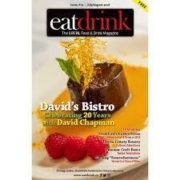Mom & Dad in the Kitchen
With Mother’s Day and Father’s Day on the horizon, some parents may be treated to a special meal prepared lovingly, but not so expertly, by their children – say a misshapen smiley face pancake with a strawberry nose, chocolate chip eyes, and whipped cream hair for breakfast. But we all know, for the balance of the year, it is the parents who slug it out in the kitchen to prepare endless meals to nourish a growing family. I’m a new parent myself, so when I came across a book about a father’s exploits in the kitchen, I took notice as a way to better influence the eating habits of the two fruits of my own loins. Hungry Monkey: A Food-Loving Father’s Quest to Raise an Adventurous Eater by Matthew Amster-Burton is a stay-at-home dad’s approach to ensure his daughter’s palette grows beyond a puerile affection for grilled cheese sandwiches by introducing her to his favourite international meals. Once his wife stopped breastfeeding their newborn, Matthew was perturbed that his daughter, Iris, seemed content with eating formula, which to him was worse than artificial coffee whitener. How could she have such low standards in taste, he asked? Maybe he was jumping the gun on this, since his daughter was only nine months old, but his intentions were good and by the end of the book, Iris has reached the ripe old age of four and his attempts have been somewhat successful in broadening her good taste in food: she eats sushi as much as hot dogs, was eating Pad Thai at nine months, turns up her nose if not served a certain brand of expensive, artisan bacon, and Martha Stewart’s Everyday Food is her favourite magazine.
Matthew believes his success comes from his self-prescribed First Rule of Baby Food which states: “There’s no such thing as baby food.” He and his wife steered clear of traditional pureed food and baby cereal and had Iris eat a mashed-up, sliced-up version of whatever they were eating for dinner. But then again, one-year-olds just starting out with solid foods seem to eat anything that you’ll let them put in their mouths. It’s as they grow that they become discriminating, and if there is one message the book conveys, it is that most children around the age of two seem to develop the same pickiness, messiness, and irrationality when it comes to food choices (such as stating a strong hatred for cheese, but then continuing to have several grilled cheese sandwiches per week).
The struggle with vegetables seems to be a perpetual battle for parents. Matthew asks his readers, “Did you know that two vegetable-loving parents who serve vegetables at every meal can have a kid who only likes potatoes?” Yes, I think all parents know this dilemma. Matthew’s solution was to have Iris help him garden potted plants on their patio to grow the leafy green stuff she said she doesn’t like. Having a hand in the production seemed to allay her suspicions about veggies. She also helps prepare food quite often, fun things like rolling lasagne noodles through a pasta machine, and is allowed to pick carte blanche what is made for the family dinner once a week. Matthew’s approach was to relish food and share that love with his family, making it fun for his daughter, but also pointing out the stressful aspects of being responsible for feeding a child.
Not to leave mothers out of this mix I’ll slip in another book, for comparative purposes, that includes a hilarious, female rendition of child-rearing from the culinary viewpoint in Shut Up and Eat! Tales of Chicken, Children, and Chardonnay by award-winning, parenting columnist, Kathy Buckworth. With four kids between the ages of seven and seventeen, she delves into the trials of mealtimes because she says that “next to getting your child to sleep, getting your child to eat is one of the most frustrating parts of parenthood.” Rather than Hungry Monkey’s culinary appreciation approach, Shut Up and Eat! is more of a survival guide to make it through all those meals throughout the day, while trying not to be ridiculed for being a terrible cook by her own small army of picky eaters. On top of the need to prepare meals, Kathy has developed a food-related nemesis – the snack, in a world with an ever-increasing need for food between meals. Matthew, on the other hand, has a different opinion of snacks: “Eating five of six small meals a day is popular diet advice, but for a baby or toddler, it’s not a lifestyle choice – it’s absolutely necessary, because they have tiny stomachs and seem to digest food as fast as garbage disposals. Snack quickly becomes an official meal, as vital as lunch.”
Whereas Matthew set out to educate a developing palate with gourmet offerings, Kathy sticks to traditional and homey recipes that are easy, like casseroles and meatloaf, for helping a busy mom survive. She is not looking to introduce her kids to fancy food and the objective of dinner time is not “to win a culinary award; it’s to get everyone around the table for at least 45 minutes.” Her recipes are meant to make moms’ lives easier so they aren’t elaborate or time-consuming, but show that some effort has been put forth. Her cooking advice tends toward the ridiculous, if not comically practical – such as using a cedar plank for cooking salmon on the barbeque, when she says “most grocery stores carry them, or grab something from the remnant pile next to your new fence.” A couple of tips from Kathy are: Hot sauce is “a miracle sauce that covers all complete cooking disasters” and precooked bacon is simply “manna from heaven.”
Kathy’s recipes are not strict and she even fine-tunes them to what kids may or may not like with practical instructions like “Sprinkle a bit of pepper on top (if the kids really don’t like pepper and see every speck as an insult to their taste buds, just skip this step).” When serving leftovers, if they were not liked the first time around, she learned to be prepared for a battle at the dinner table when serving the same unappreciated, re-heated dish two days in a row. Matthew, however, is a big proponent of leftovers, always making sure there will be enough to heat up for the next day’s lunch.
Kathy is a mother, an author, and a home cook. Matthew is a father, an author, and a home cook. Is there a gender differentiation? Kathy writes: “I’m not a born cook. I’m not a born domestic anything. And why should I be? Because I have ovaries? I don’t think so. But necessity is the mother of invention, and I’m the mother inventing this book in order to get the stupid breakfast/lunch/dinner on the table so we can all get on with the rest of our lives.” As a restaurant and food critic, Matthew has more of an affinity for his topic and acknowledges that “there are issues associated with being a female cook that I will never have to worry about. Men hardly ever feel like they’re trapped in the kitchen turning out dinner for an ungrateful family”, which is Kathy’s perception some of the time.
It is not only the cooking aspect of feeding children that both authors write about. There are also restaurant outings, grocery shopping, and dinner parties that prove challenging with kids in tow. Holiday meals are especially memorable when you have kids. Most of our favourite personal recipes come from our parents, grandparents, or even crazy Aunt Sally. And with a full house of in-laws, siblings, and all those kids each holiday meal turns into a mishmash of favourite family recipes. Cooking for kids and with kids can be fun and frustrating all at once, rolled together in one endless family bonding experience. Kathy calls the family unit of Mom, Dad, and Offspring an “unholy trinity of folks responsible for food-related issues in any given home”, but maybe, that smiley face pancake will eventually come along and all is forgiven.











